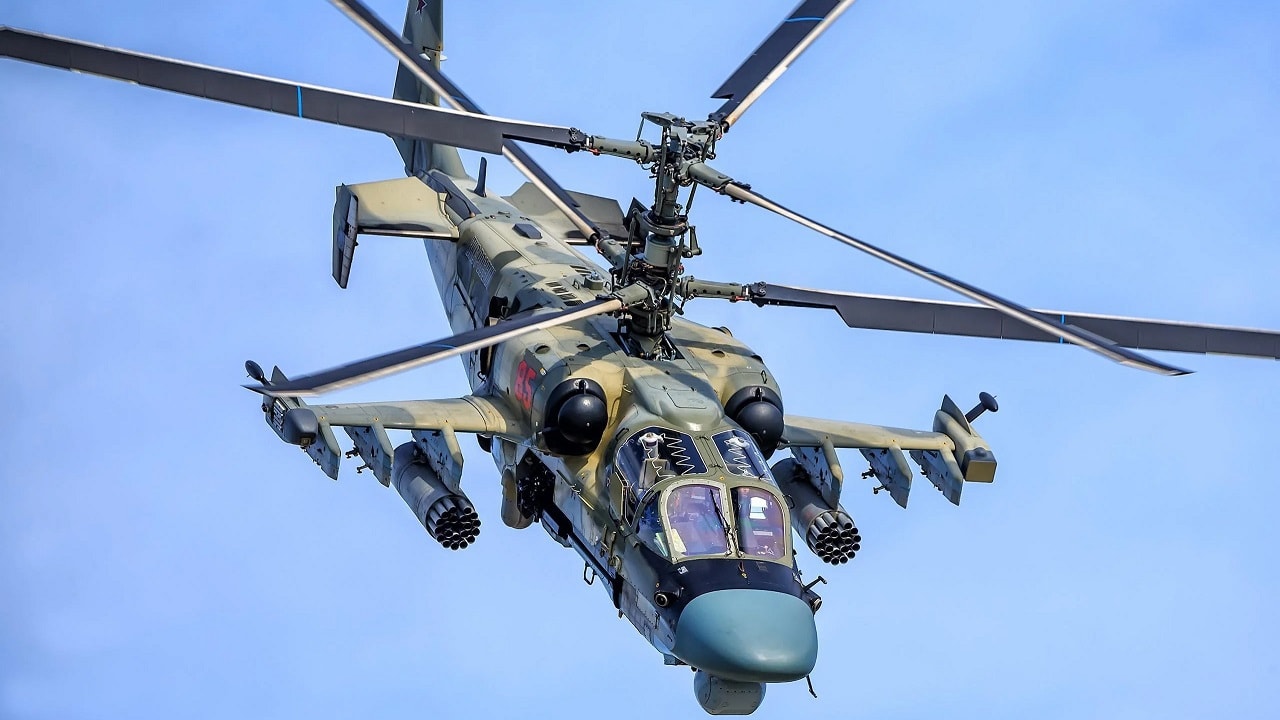Have powerful Russian helicopter gunships been neutralized as a threat on the battlefield in Ukraine? The Ka-52 Alligator attack helicopter is Russia’s answer to the American Apache gunship. The Ka-52 helicopter is a formidable adversary, but Ukraine has not been intimidated. Ukraine claims to have destroyed at least four Alligators in the early days of the war.
Ka-52 Blitz on Key Airport in Ukraine
When the invasion first began, Russia had a plan to immediately take the capital of Ukraine. Use a large force of Russian airborne troops and Spetsnaz special forces to blitz the Antonov strategic airport at Gostomel. Then take that military base to bring in even more Russian follow-on troops and hardware. This group of 34 helicopters was escorted by Alligator attack choppers hoping to overwhelm Ukrainian defenses on the morning of February 24.
Ukraine Is Not Intimidated
It didn’t work according to plan and the Ukrainians made the pilots of the Alligator pay with heat-seeking air defense missiles as the attack was repulsed in heavy fighting. The Russians attempted to eliminate radar-controlled surface-air-missiles but they didn’t plan for the Ukrainians to effectively use shoulder-fired anti-aircraft systems such as the Soviet-era Strelas or Iglas.
Plan Is Stymied
That initial defeat shouldn’t have happened. Alligators are designed to spray huge amounts of suppressive fire to keep enemy heads down so other helicopters can deliver troops in air assault operations. The Alligator has double-rotors for more speed, side-mounted 30-millimeter cannons, and a dozen Ataka anti-tank guided missiles on its wings. The weapons do not stop there. The aircraft has “hardpoints that can carry VIKHR anti-tank guided missiles (ATGM)…and B8V-20 rocket launchers for 80mm unguided S-8 rockets,” according to Air Force Technology.
Advanced Helicopter Has Advanced Targeting
The Alligator first flew in 1997 and began manufacturing in 2008. By 2011, the Ka-52 entered service in numbers with the Russian air force. There are about 70 in the Russian fleet. Two crew members sit side-by-side. They each have helmet-mounted displays along with a heads-up display on the front windshield to improve the weapons’ targeting and delivery.
Alligator Has Elite Countermeasures
The Ka-52 difficulty with Ukrainian missile defenses should have been mitigated with the helicopters advanced electronic countermeasures suite. It has jamming pods, radar warning, and laser detection. The Alligators should have released chaff and flares to ward off heat-seeking missiles. The pilots must have been surprised to be hit with missile fire from the MANPADs (Man-portable air-defense systems).
It’s a Fast and Agile Chopper
The Russians also believe the Ka-52 has the speed and agility to maneuver its way through contested air space. Two turboshaft engines put out a top speed of 192 miles per hour. Its armor is also designed to withstand anti-aircraft hits.
But this video shows a downed Ka-52 that crashed and burned in Kherson due to air defense fire from Ukrainian forces. Not to be outdone, the Russians have put out their own video showing successful attacks from the Alligator.
The Russians Are Left Scratching Their Heads
The overall performance of the Ka-52 must be mystifying and frustrating for the Russians. Here is a world-class gunship falling to shoulder-fired missiles. It conjures bad memories of Russian difficulties against insurgent-fired Stinger missiles during the Soviet war in Afghanistan.
The Russians may have to adjust tactics and fly the Alligator at higher altitudes and require their pilots to release more flares to try and spoof the heat-seeking missiles. This is another example of the Ukrainians neutralizing an aircraft that was supposed to use overwhelming firepower and shock and awe to intimidate the Ukrainians. But the defenders are showing no fear and making Alligator pilots think twice when it comes to attacking the Ukrainians defending their homeland.
Now serving as 1945’s Defense and National Security Editor, Brent M. Eastwood, PhD, is the author of Humans, Machines, and Data: Future Trends in Warfare. He is an Emerging Threats expert and former U.S. Army Infantry officer. You can follow him on Twitter @BMEastwood.

